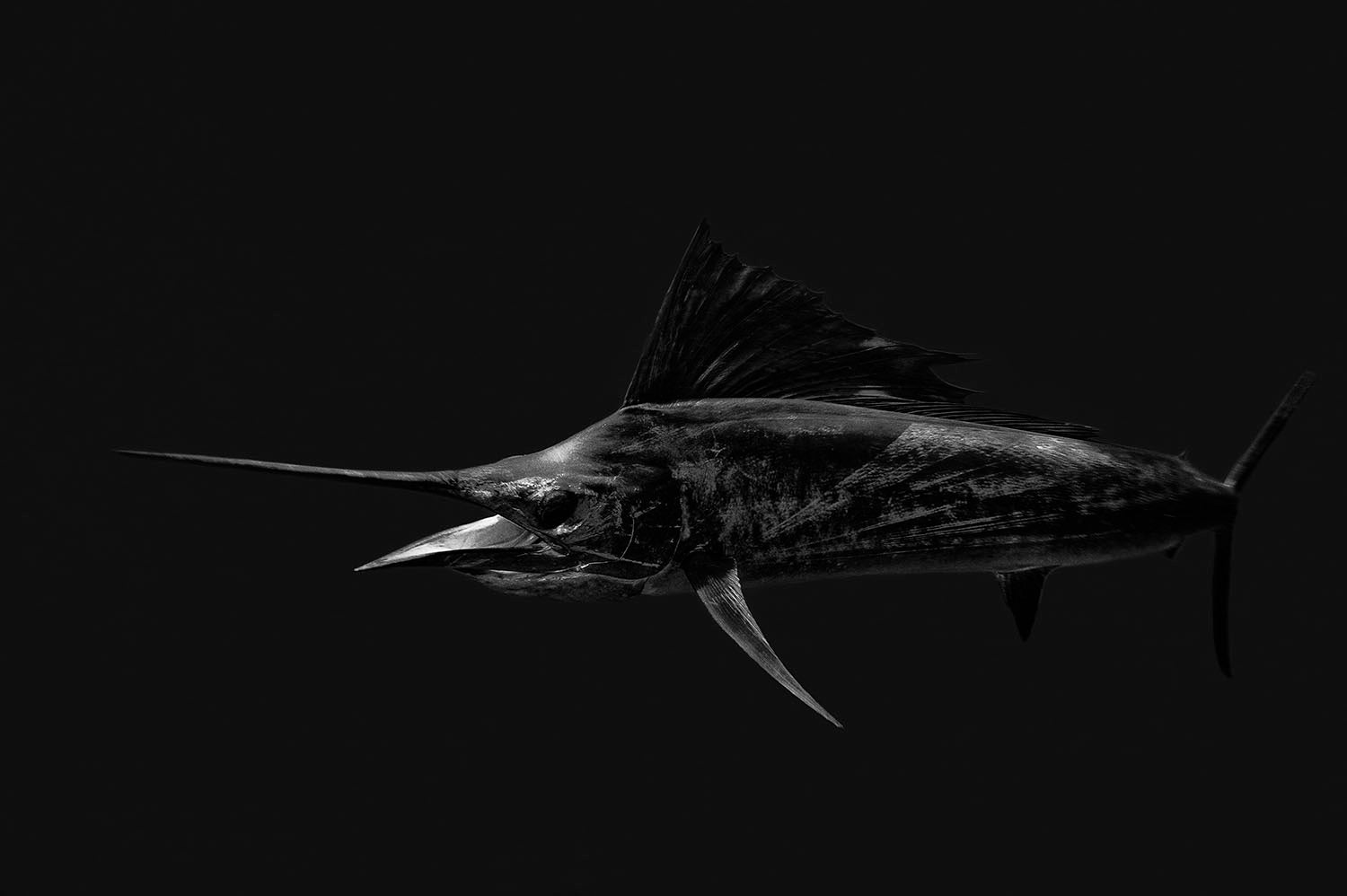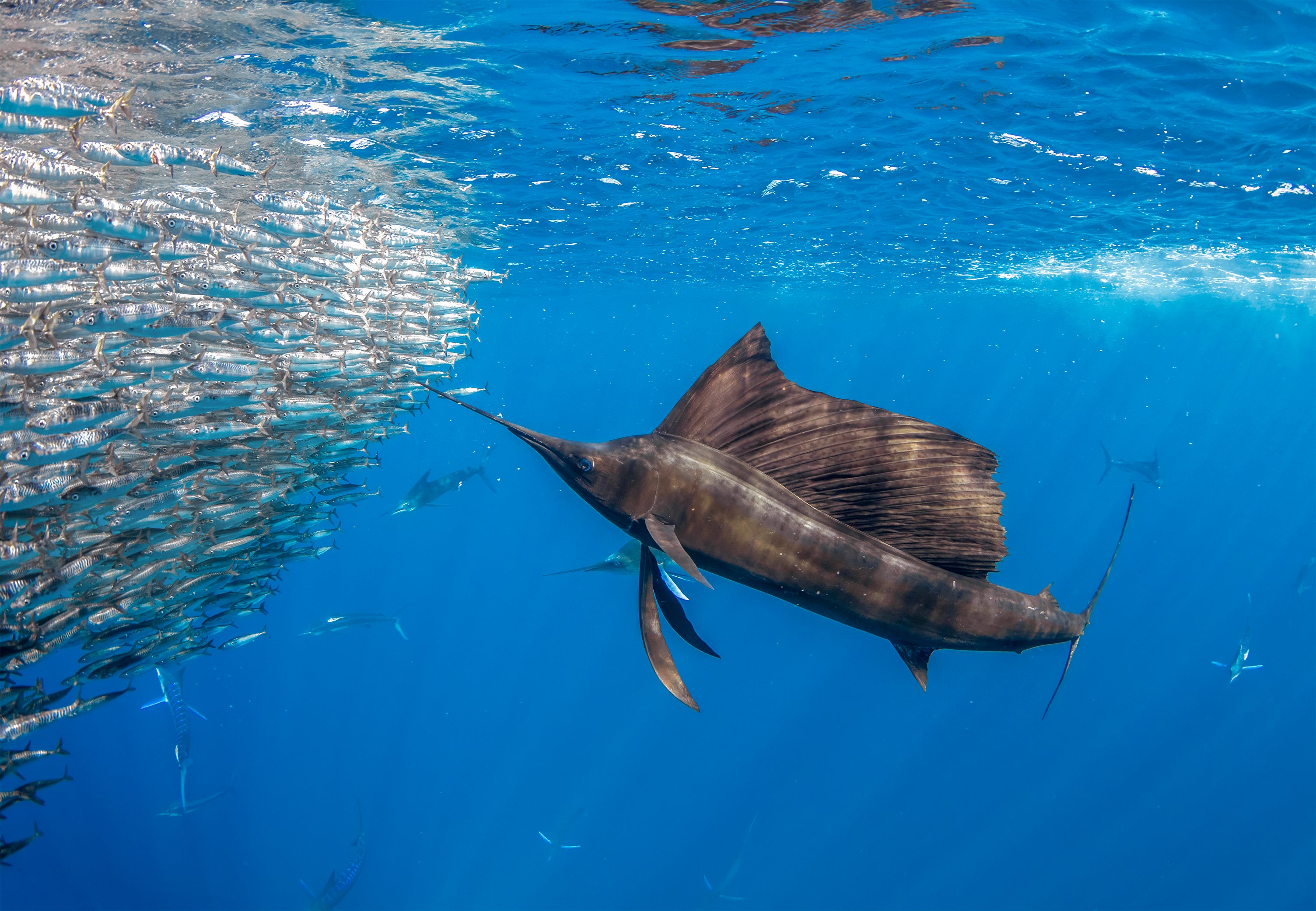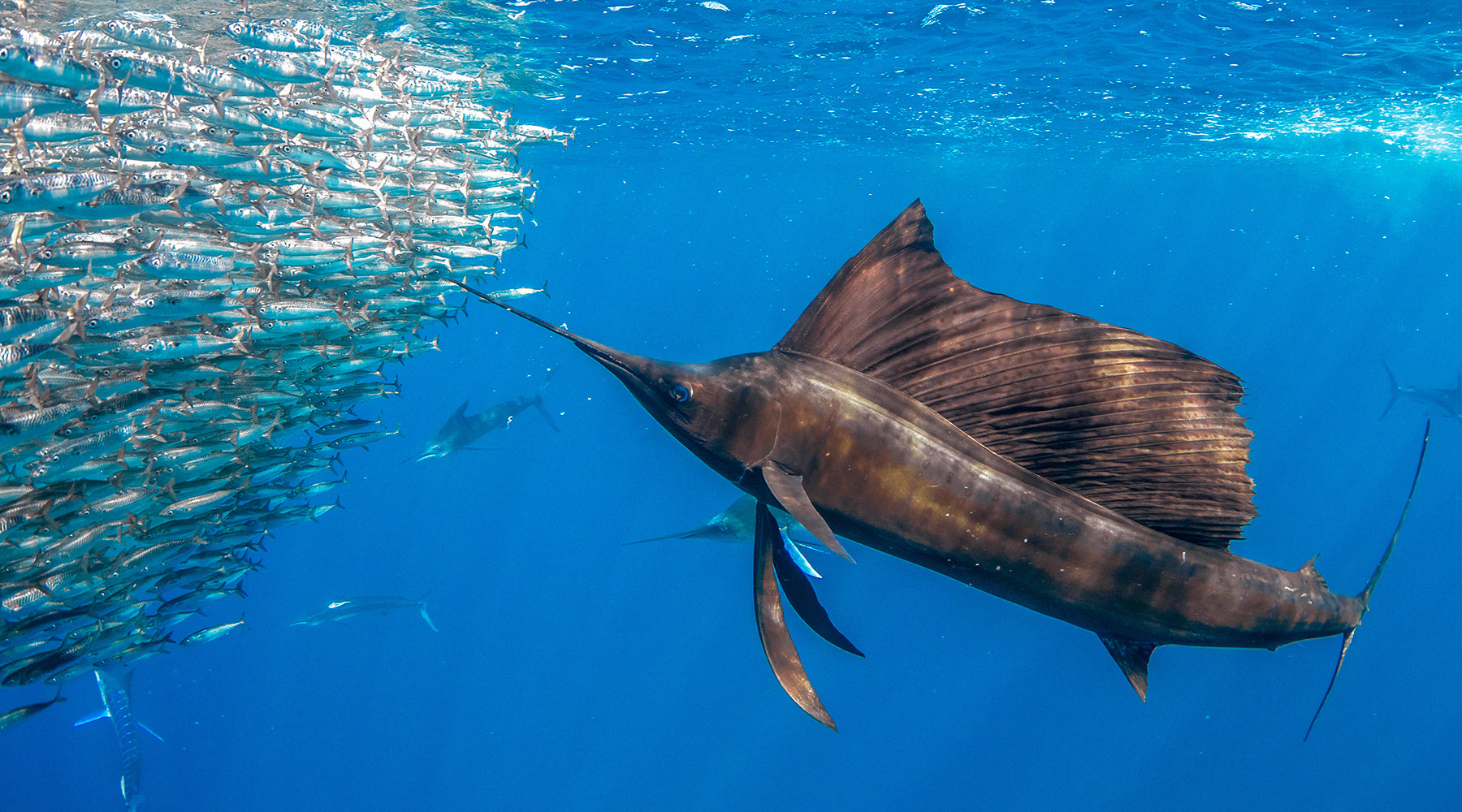12 MIN READ
4-24-2024
Master of the Waves:
Exploring the Fascinating World of the Sailfish
Henry Bliss, 4ocean Story Producer
Embark on a journey beneath the ocean’s surface and learn more about the Sailfish (Istiophorus).
A fleeting vision of elegance and speed emerges from the sailfish in the vast expanse of the open ocean. With its streamlined body slicing through the waves and its iconic sail-like dorsal fin catching the sunlight, the sailfish captivates observers with its unparalleled grace and beauty.

Diana Dowd @dianawdowd
Renowned for its incredible speed and agility, the sailfish is among the fastest fish in the sea, capable of reaching speeds of up to 68 miles per hour. As an apex predator, it plays a vital role in maintaining the balance of oceanic ecosystems, showcasing both the beauty and complexity of the marine world.

Kevin Dodge - dodgeocean.com
Habitat Overview:
Sailfish are primarily found in warm oceanic waters, both offshore and near coastal regions, typically inhabiting tropical and subtropical areas around the world. They prefer waters with temperatures ranging from 70°F to 83°F (21°C to 28°C). Sailfish are highly migratory and can be found in the Atlantic, Pacific, and Indian Oceans.

Diana Dowd @dianawdowd
Seasonal Movements: In some regions, sailfish exhibit seasonal movements, following the warmer waters as they shift throughout the year. For example, in the Atlantic Ocean, sailfish may migrate northward during the warmer months and then southward as temperatures drop.
Breeding Migration: Sailfish undertake long-distance migrations for breeding purposes. Depending on the region, sailfish may travel hundreds or even thousands of miles to reach spawning grounds during the breeding season. These migrations often coincide with changes in ocean currents and food availability.
Oceanic Currents: Sailfish utilize ocean currents to aid their migrations. They may follow warm currents, such as the Gulf Stream in the Atlantic Ocean or the Kuroshio Current in the Pacific Ocean, providing suitable temperature conditions and abundant prey along their routes.
Feeding Migrations: Sailfish are opportunistic feeders and may undertake migrations in search of areas with high prey concentrations. They follow schools of baitfish, such as those found in upwelling zones or along continental shelves, where nutrient-rich waters support a thriving ecosystem.

Diet: Sailfish have a diverse diet primarily consisting of smaller pelagic fish species. Some of their main prey items include:
Sardines, small schooling fish abundant in many oceanic regions that serve as a primary food source for sailfish.
Mackerel: Another common prey item, mackerel, is a medium-sized fish that forms dense schools, making it vulnerable to predation by sailfish.
Anchovies: These small, silvery fish are a staple food for many marine predators, including sailfish, and are often found in large aggregations.
Squid: Sailfish also consume cephalopods like squid, which they catch using their speed and agility to chase and capture.
Crustaceans: While less common in their diet than fish, sailfish may opportunistically feed on crustaceans such as shrimp and crabs when they are available.

Eli Martinez @sdmdiving
Behavior
Sailfish exhibit various behaviors that reflect their specialized adaptations for hunting, feeding, reproduction, and social interaction. Their role as apex predators underscores their significance in marine ecosystems, contributing to the intricate web of predator-prey dynamics and helping maintain the health and balance of oceanic habitats.
Hunting Strategies
Speed and Agility: Sailfish are renowned for their incredible speed, capable of reaching bursts of up to 68 miles per hour (110 kilometers per hour). They use their streamlined bodies and powerful tail fins to propel themselves through the water with remarkable agility.
Cooperative Hunting: While sailfish can hunt individually, they often behave cooperatively, especially when targeting schools of prey fish. They may work together to corral prey into tight formations, making it easier to launch coordinated attacks.
Feeding Behaviors
Slash and Stun: Sailfish use their elongated bills to slash at prey, stunning them before engulfing them whole. This technique helps incapacitate fast-moving prey and facilitates efficient feeding.
High-Energy Expenditure: Hunting and capturing prey can be an energetically demanding activity for sailfish due to their need for speed and agility. As a result, they must consume substantial amounts of food to sustain their high metabolic rate.

bracelet of the month: sailfish
Pull 5 pounds of trash from the ocean with our limited edition Sailfish Bracelets. Only available May 2024!
SHOP NOW + CLEAN THE OCEANSocial Structure
Solitary and Group Behavior: Sailfish are typically solitary hunters but may form loose aggregations or small groups, especially when hunting in areas with abundant prey. These groups are often transient and may disband once feeding opportunities diminish.
Communication: While not extensively studied, it's believed that sailfish communicate with each other through visual signals, body language, and possibly subtle changes in behavior. These communication cues help coordinate group hunting efforts and maintain social cohesion.
Feeding Behaviors
Courtship Displays: During the breeding season, male sailfish may engage in elaborate courtship displays to attract females. These displays may involve fin displays, color changes, and synchronized swimming patterns.
Spawning: Sailfish are pelagic spawners, releasing their eggs and sperm into the ocean. Fertilized eggs hatch into larvae, drifting with ocean currents before eventually developing into juvenile fish.

Amanda Cotton @acottonphoto
How does plastic pollution impact sailfish?
Ingestion:Sailfish may accidentally ingest plastic debris while feeding. This can occur when they mistake plastic items, such as discarded bags or fragments, for prey. Ingested plastic can lead to internal injuries, blockages in the digestive tract, and malnutrition.
Entanglement:Sailfish may become entangled in abandoned or discarded fishing gear, such as plastic nets, lines, and traps. This can result in injuries, impaired movement, and even death. Entanglement in plastic debris can hinder their ability to swim, hunt, and evade predators, ultimately affecting survival.
Habitat Degradation:Plastic pollution can degrade sailfish habitats, including coral reefs, coastal areas, and open ocean ecosystems. Accumulated plastic debris can smother and damage coral reefs, disrupt nesting sites, and alter the availability of prey species. This degradation can indirectly impact sailfish by reducing their access to food sources and disrupting their natural habitat.
Chemical Contamination:Plastics in the marine environment can absorb and accumulate harmful chemicals and pollutants, such as persistent organic pollutants and heavy metals. When ingested by sailfish, these toxic compounds can bioaccumulate in their tissues, potentially leading to health problems, reproductive issues, and compromised immune function.
Microplastic Ingestion:Microplastics, tiny plastic particles less than 5 millimeters in size, are increasingly prevalent in marine ecosystems. Sailfish may inadvertently consume microplastics directly or indirectly through their prey. These microplastics can accumulate in their digestive systems, potentially causing inflammation, reduced nutrient absorption, and other adverse health effects.

Diana Dowd @dianawdowd
The sailfish stands as a remarkable testament to the marvels of marine life, embodying grace and power in the vast expanse of the ocean. With its unparalleled speed, agility, and predatory prowess, the sailfish occupies a pivotal role as an apex predator, shaping the dynamics of marine ecosystems. However, despite its natural prowess, the sailfish is not immune to the mounting challenges posed by human activities, including plastic pollution, habitat degradation, and overfishing. As stewards of the oceans, we must recognize the importance of safeguarding the delicate balance of marine ecosystems and preserving the awe-inspiring beauty of species like the sailfish.
We’re always on the lookout for incredible stories from our community! Pitch yours to our team at stories@4ocean.com


